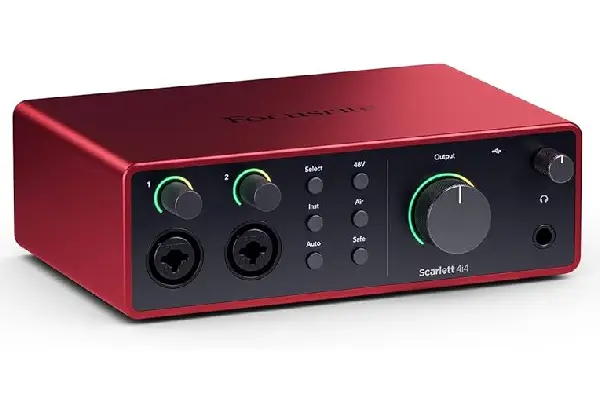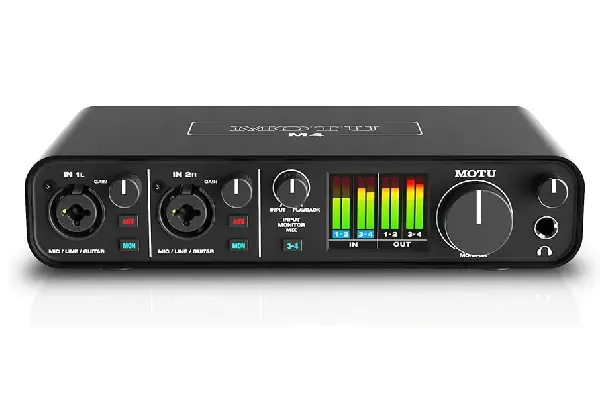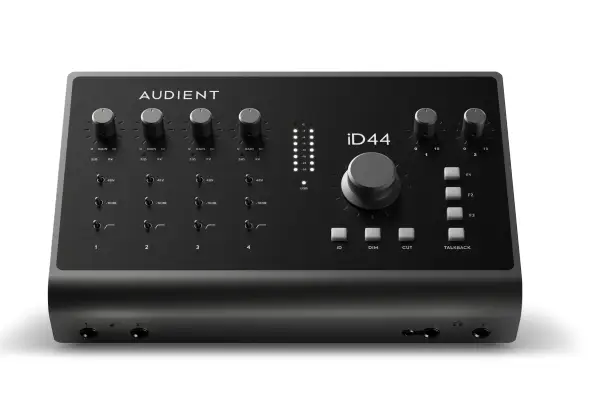The best audio interfaces under $500 have evolved dramatically, offering pristine preamps, rock-solid drivers, and feature sets that rival gear costing twice as much just a few years ago. Whether you’re tracking vocals in your bedroom, recording a full band, or producing electronic music that demands crystal-clear monitoring, this price range delivers genuine studio-quality results without the professional studio price tag.
The interfaces I’ve selected represent different approaches to the same goal: capturing your sound with transparency and reliability. I’ve prioritized low-latency performance, preamp quality, build durability, and real-world usability over flashy features that sound impressive in marketing materials but rarely get used in actual sessions.
| Model | Key Strengths | Pros | Cons |
|---|---|---|---|
| Focusrite Scarlett 4i4 (4th Gen) | Clean, modern preamps with Air mode, flexible 4-input layout, and reliable low-latency performance | • Very clear preamps + Air mode• Stable drivers on Mac/Windows• Strong software bundle (Hitmaker Expansion)• Four inputs offer real flexibility• Loopback ideal for streaming• Powerful low-latency monitoring | • No onboard DSP• Uses traditional DIN MIDI• Some rivals offer more inputs• Plastic gain knobs feel less premium |
| Universal Audio Volt 276 | Transformer-coupled preamps + built-in 76 compressor deliver genuine analog coloration uncommon at this price | • Transformer preamps provide warm tone• Excellent 76 Compressor• All-metal high-quality build• UA Connect models useful preamp tones• Strong converters• Vintage mode adds sweet saturation | • Only two inputs• No per-channel phantom power• Bulkier/heavier than competitors• Requires UA account + online setup |
| MOTU M4 | ESS Sabre32 converters + precise LCD metering provide the cleanest measurements and best gain staging in the class | • Elite ESS Sabre32 conversion• Full-color LCD meters• Ultra-transparent preamps• Great loopback for creators• Four outputs allow flexible routing• Metal construction, compact design | • Transparent sound may feel “sterile”• No pad switches• Headphone amp could be stronger• Routing features may overwhelm beginners |
| PreSonus Studio 24c | Clean XMAX-L preamps with excellent Studio One integration and intuitive monitoring workflow | • Tight Studio One workflow• Forgiving, clean XMAX-L preamps• Useful software bundle• Good cue mix for overdubs• Durable metal chassis• Easy controls for beginners | • Only two inputs• No onboard DSP• Some settings require DAW menus• USB-C may need adapters on older systems |
| Audient iD44 | Console-grade preamps + huge I/O count + ADAT expansion make it a project-studio powerhouse | • Large I/O eliminates limitations• Warm, console-style preamps• Excellent dual JFET DI inputs• ADAT expansion for future growth• Comprehensive monitoring + talkback• ScrollControl improves workflow | • Large footprint• Nearing $500+ price range• Overkill for small setups• Learning curve for advanced features |
Focusrite Scarlett 4i4 (4th Gen)

The fourth-generation Scarlett 4i4 represents Focusrite’s continued refinement of what’s become an industry standard for home recording. After working with three previous Scarlett generations, I immediately noticed the improved preamp clarity in this latest iteration—there’s a transparency to the high-end frequencies that wasn’t quite there in earlier models. The four-input configuration hits that perfect balance for solo artists and small production setups, giving you enough flexibility to record a vocal with a stereo keyboard setup or capture a guitar amp with room mics simultaneously.
What sets this interface apart in daily use is the Air mode on the preamps, which adds a subtle high-frequency lift that genuinely mimics the character of Focusrite’s ISA preamps. The unit’s build quality feels substantial without being bulky—the metal chassis can handle the accidental coffee spill or getting knocked around in a home studio environment. The rear-panel MIDI I/O might seem like a throwback feature in our USB-everything world, but it’s invaluable when you’re integrating vintage synthesizers or hardware drum machines into modern productions.
During extended mixing sessions, the headphone output delivers enough clean power to drive both my studio reference headphones and higher-impedance monitoring cans without audible strain or distortion. The companion software package includes genuinely useful plugins rather than bloatware, with the Hitmaker Expansion providing bread-and-butter compressors and EQs that work well for quick demo production. For anyone comparing options across different categories of music gear, similar to how you’d evaluate professional monitoring solutions, the Scarlett 4i4 represents that reliable workhorse mentality where consistent performance trumps exotic features.
Pros:
- Exceptional preamp clarity with useful Air mode enhancement
- Rock-solid driver stability across Mac and Windows platforms
- Comprehensive software bundle with professional-grade plugins
- Four inputs provide genuine flexibility for various recording scenarios
- Loopback functionality perfect for podcasters and streaming content creators
- Low-latency monitoring that makes tracking feel immediate and natural
Cons:
- No onboard DSP for effects processing during recording
- MIDI implementation requires traditional DIN cables rather than USB-MIDI
- Some competitors offer more inputs at similar price points
- Plastic gain knobs feel slightly less premium than the metal chassis suggests
Universal Audio Volt 276

Universal Audio’s entry into the affordable interface market brought their transformer-coupled preamp heritage to bedroom producers, and the difference is immediately audible. The Volt 276 incorporates actual audio transformers in the signal path, which imparts a subtle harmonic richness that makes acoustic instruments and vocals sound more three-dimensional compared to typical solid-state designs in this price range. I’ve recorded dozens of acoustic guitar sessions through the Volt 276, and there’s a fullness to the low-mids that helps fingerstyle playing sit perfectly in a mix without requiring excessive EQ sculpting later.
The vintage compressor mode, modeled after UA’s classic 1176, provides genuinely usable gain reduction that sounds musical rather than obviously processed. During vocal tracking sessions, I’ve found myself printing takes with the compressor engaged more often than not—it adds a professional polish that makes rough demos sound more finished. The built-in 76 Compressor responds to transients with that characteristic fast attack that tames sibilance naturally while maintaining vocal energy. What surprised me most after extended use was how much the interface improved my monitoring accuracy; the converter quality reveals subtle production details that were previously masked by lesser interfaces.
The UA Connect software ecosystem deserves mention for its genuinely useful preamp modeling plugins that work during tracking. Being able to audition different preamp characteristics while recording helps commit to tonal decisions early in the production process. For producers creating content across multiple genres, much like selecting the right instrument for your musical style, the Volt 276 offers tonal versatility that adapts to different recording scenarios without sounding overly colored or characterless.
Pros:
- Transformer-coupled preamps deliver genuine analog warmth and harmonic complexity
- Built-in 76 Compressor sounds musical and professional without excessive processing artifacts
- Exceptional build quality with metal construction throughout
- UA Connect software provides useful preamp modeling during recording
- Converter quality rivals interfaces costing significantly more
- Vintage mode adds pleasing saturation that enhances rather than distorts source material
Cons:
- Limited to two inputs restricts simultaneous recording options
- No onboard phantom power switches for individual channels
- Heavier and bulkier than comparable two-channel interfaces
- Software features require account registration and online connectivity
MOTU M4

The MOTU M4 represents the engineering-focused approach to interface design, prioritizing measurable performance specifications over vintage character or marketing slogans. After testing the preamps with both dynamic and condenser microphones across various acoustic environments, the transparency is genuinely impressive—what you hear through your monitors is an accurate representation of what’s happening at the microphone capsule. The ESS Sabre32 DAC technology delivers 120dB dynamic range, which translates to incredibly low noise floors that keep your recordings clean even when applying significant digital gain during mixing.
What makes the M4 exceptional for its price point is the LCD metering on the front panel, providing precise visual feedback for gain staging without relying on software meters that introduce monitoring latency. I’ve found myself setting input levels more accurately and quickly compared to interfaces that only offer LED clip indicators. The loopback routing functionality proves invaluable for content creators who need to capture system audio alongside microphone inputs—perfect for podcast interviews, streaming setups, or creating tutorial content where you’re demonstrating software while providing voiceover commentary.
The four-output configuration opens creative routing possibilities that two-output interfaces can’t match. The unit’s compact footprint belies its professional capabilities, and the all-metal construction feels like it could survive a decade of daily studio use without developing the wobbly potentiometers or scratchy controls that plague cheaper interfaces. For producers evaluating different monitoring options, similar to comparing portable listening solutions, the M4’s honest sonic reproduction ensures what you mix will translate accurately to other playback systems.
Pros:
- Exceptional measured performance specifications with 120dB dynamic range
- Front-panel LCD metering provides precise visual feedback for gain staging
- Ultra-transparent preamps that don’t color the source material
- Loopback functionality perfect for streaming and content creation workflows
- Four outputs enable creative routing and hybrid mixing setups
- Compact design maximizes desk space efficiency
Cons:
- Some users find the transparent sound lacks character compared to colored preamps
- No pad switches on inputs limits headroom with extremely hot sources
- Headphone output could provide more power for high-impedance monitoring
- Learning curve for advanced routing features may overwhelm beginners
PreSonus Studio 24c

PreSonus brings their decades of studio equipment manufacturing experience to the Studio 24c, creating an interface that feels immediately familiar to anyone who’s worked in professional recording environments. The XMAX-L preamps deliver clean gain with enough headroom to handle both whisper-quiet performances and aggressive rock vocals without strain or distortion. After tracking numerous vocal sessions through the Studio 24c, I’ve noticed how forgiving these preamps are with budget microphones—they extract surprisingly good performance from entry-level condensers that sound thin and harsh through lesser interfaces.
The integration with PreSonus’s Studio One DAW creates a streamlined workflow that eliminates the frustrating configuration hurdles common when mixing manufacturers’ ecosystems. The included Artist version of Studio One provides a genuinely capable production environment rather than the crippled “lite” versions many interfaces bundle. The MIDI I/O proves more useful than expected in an era dominated by virtual instruments, particularly when integrating hardware synthesizers or vintage MIDI controllers that lack USB connectivity.
What surprised me most about extended use was the headphone amplifier’s quality—it drives my reference monitors with enough clarity and power that I’ve completed entire mixing projects using headphones exclusively when working late-night sessions. The cue mix functionality allows performers to hear themselves with custom levels independent of your main monitor mix, which proves invaluable during vocal overdub sessions where singers need more of themselves and less backing track. For musicians exploring different creative approaches, much like discovering new musical inspiration, the Studio 24c’s tight DAW integration removes technical barriers between creative ideas and finished recordings.
Pros:
- Excellent Studio One DAW integration streamlines entire production workflow
- XMAX-L preamps deliver clean, forgiving performance with various microphone types
- Robust software bundle provides genuinely useful production tools
- Cue mix functionality perfect for overdub sessions and vocal tracking
- Solid build quality with metal construction and reliable components
- Straightforward controls make operation intuitive for beginners
Cons:
- Only two inputs limit simultaneous recording capabilities
- No onboard DSP processing during tracking
- Some advanced features require diving into software menus rather than hardware controls
- USB-C connection may require adapters for older computer systems
Audient iD44

The Audient iD44 represents the “more is more” philosophy in interface design, packing twenty channels of I/O into a desktop form factor that doesn’t overwhelm your workspace. After using this interface for tracking full band sessions in project studios, I’ve come to appreciate how the expanded I/O eliminates the constant cable-swapping that plagues smaller interfaces. The Audient Console preamps, derived from their large-format recording console designs, deliver that slightly forward midrange character that helps rock and pop vocals sit confidently in dense mixes without fighting for space.
What sets the iD44 apart is the dual JFET instrument inputs that actually sound good—many interfaces treat DI inputs as an afterthought, but Audient’s implementation captures electric guitar and bass with the impedance loading and frequency response that makes direct recording a viable alternative to miking amplifiers. I’ve recorded entire guitar sessions direct through the JFET inputs, using amp simulation plugins, and the results have that organic feel that typically requires actual speaker cabinets. The ScrollControl feature, which turns the monitor volume knob into a DAW controller, seems gimmicky until you experience the workflow improvement of adjusting plugin parameters without reaching for your mouse.
Pros:
- Extensive I/O configuration eliminates input limitations for complex sessions
- Console-grade preamps deliver professional sound quality with vintage character
- Dual JFET instrument inputs sound exceptional for direct guitar and bass recording
- ADAT expansion allows system to grow with your recording needs
- Comprehensive monitoring features including speaker switching and talkback
- ScrollControl feature improves DAW workflow efficiency
Cons:
- Larger footprint requires more desk space than compact interfaces
- Higher price point approaches the $500 ceiling
- Some features remain underutilized in simpler recording scenarios
- Learning curve for advanced routing and monitoring features
Frequently Asked Questions
What makes an audio interface worth the investment for home recording?
An audio interface serves as the critical connection between analog sound sources and your digital recording environment, converting microphone and instrument signals into digital audio your computer can process. Quality interfaces in the sub-$500 range provide clean preamps that capture subtle performance details, low-latency monitoring that makes tracking feel immediate rather than delayed, and reliable drivers that prevent frustrating crashes during recording sessions. The difference between budget and quality interfaces becomes immediately apparent when you’re mixing—recordings captured through better converters require less corrective EQ and sound more three-dimensional in the stereo field.
While solo recording sessions typically focus on one or two microphones at a time, having additional inputs provides workflow flexibility that speeds up creative processes. Recording acoustic guitar with a stereo microphone pair while simultaneously tracking vocals requires at least three inputs, and having a fourth input available for room ambience or a DI signal eliminates the need to record multiple passes. The expanded input count also future-proofs your setup—what seems excessive today becomes essential when you start collaborating with other musicians or incorporating hardware synthesizers into your productions.
How important is preamp quality compared to converter specifications?
Both preamps and converters contribute equally to recording quality, but they affect different aspects of your sound. Preamps determine how much clean gain is available and whether the signal path adds desirable coloration or unwanted noise, while converters dictate how accurately analog signals translate into digital audio and vice versa. In the sub-$500 price range, most interfaces use competent converters that provide adequate dynamic range and frequency response—the preamp design creates more audible differences between competing models. Transparent preamps work universally well across all source material, while colored preamps add character that enhances some recordings but may be inappropriate for others.
Can budget interfaces deliver professional-quality recordings?
The interfaces featured in this price range all provide genuinely professional recording quality when used properly—the difference between these units and boutique converters costing thousands becomes apparent only in critical listening environments on high-end monitoring systems. Modern converters have reached a level of performance where proper microphone technique, acoustic treatment, and gain staging matter more than subtle converter differences. I’ve heard commercial releases tracked entirely through interfaces in this price range, and the recordings stand up against material recorded in professional facilities. The limitation typically isn’t the interface quality but rather the recording environment, microphone selection, and performer skill.
Should I prioritize onboard DSP or save money for better converters?
This decision depends on your recording workflow and whether you monitor through your computer or prefer zero-latency monitoring. Onboard DSP allows you to hear effects and processing during tracking without the latency that computer-based plugins introduce, which proves valuable for vocalists who need compression and reverb in their headphones to perform confidently. However, interfaces without DSP typically invest their budget into better preamps and converters, providing cleaner recordings that accept processing more gracefully during mixing. I’ve found that unless you’re recording vocalists who specifically request effects during tracking, the transparent recording path without onboard processing provides more flexibility and better sound quality.

